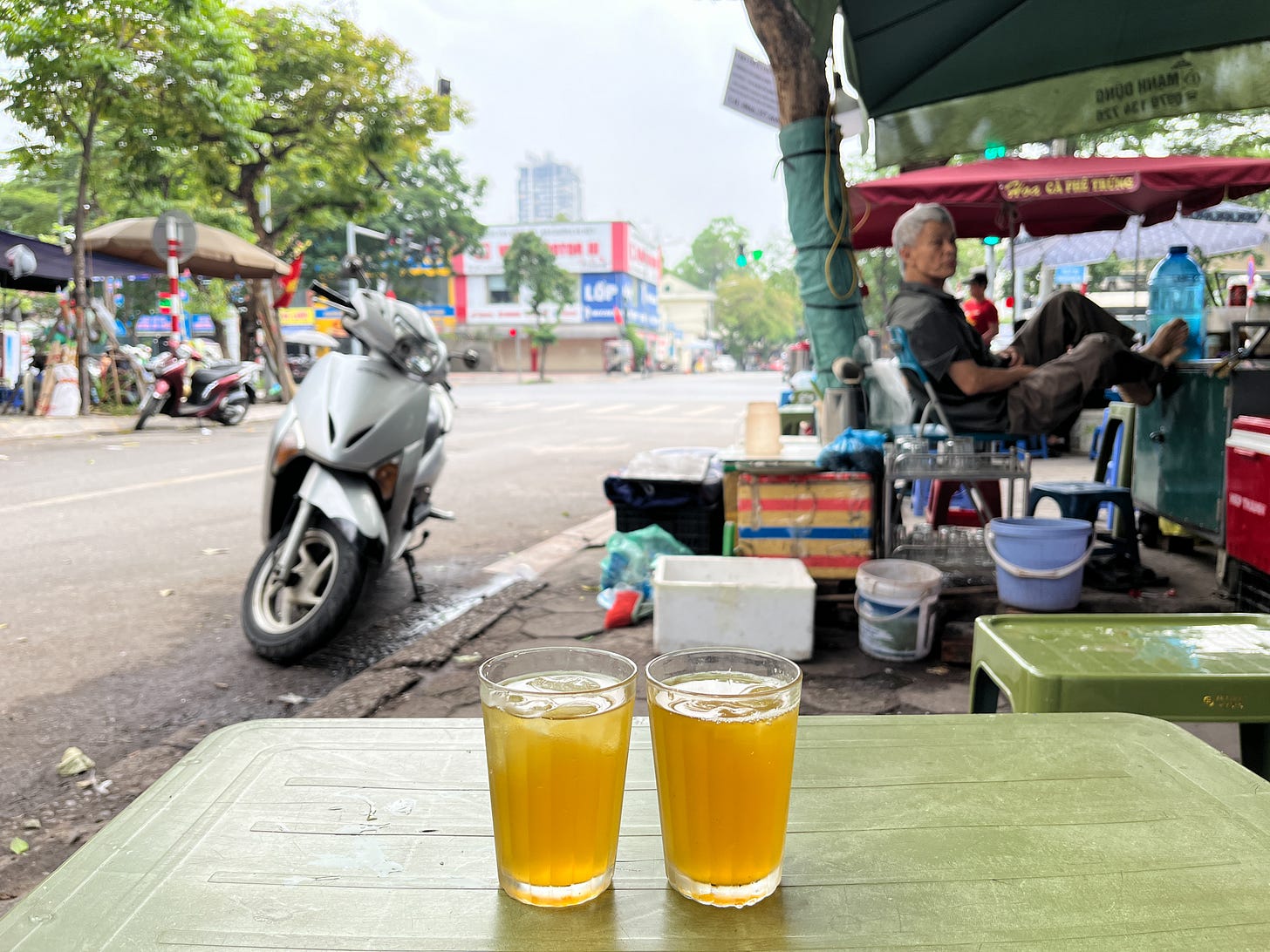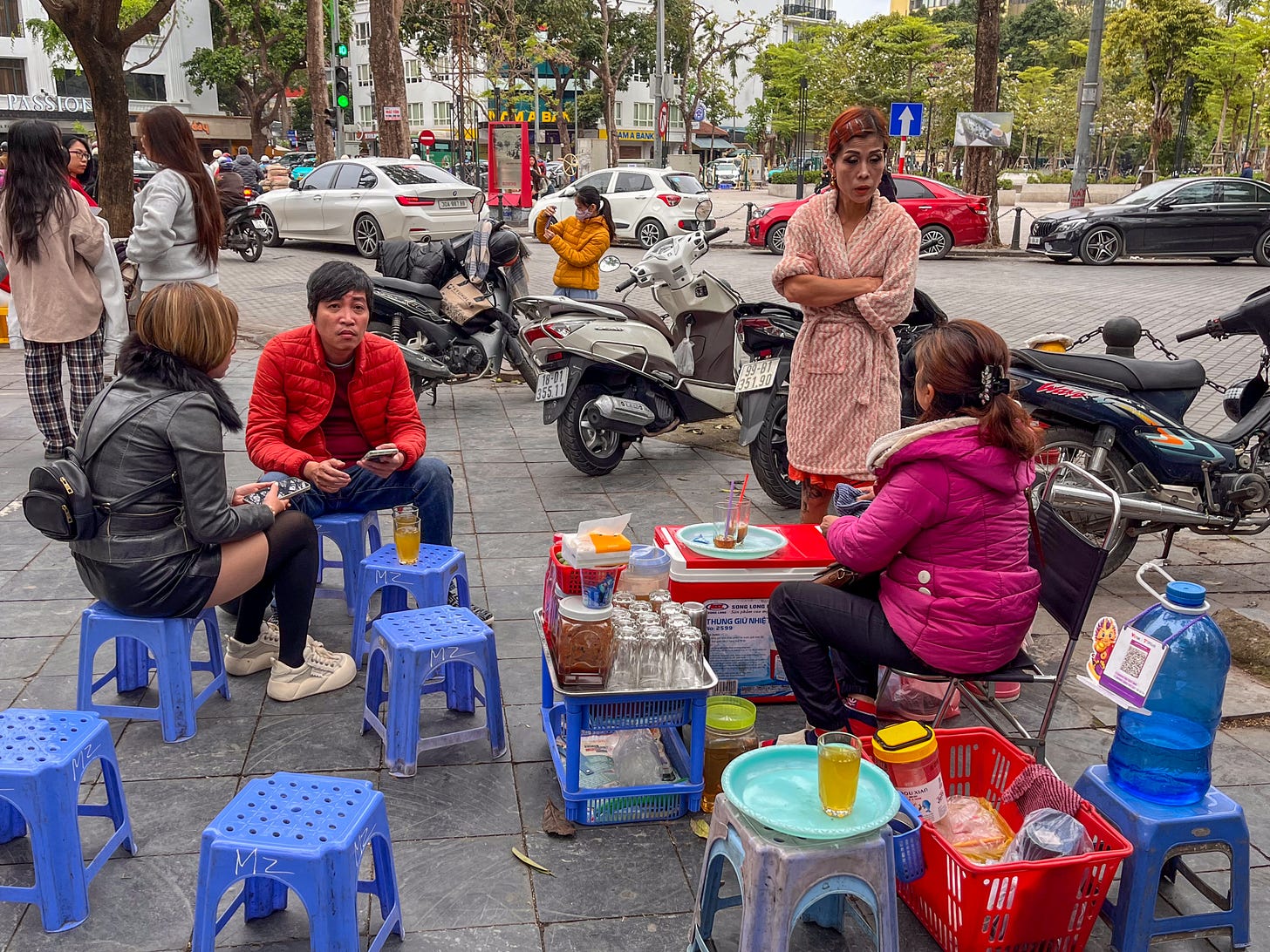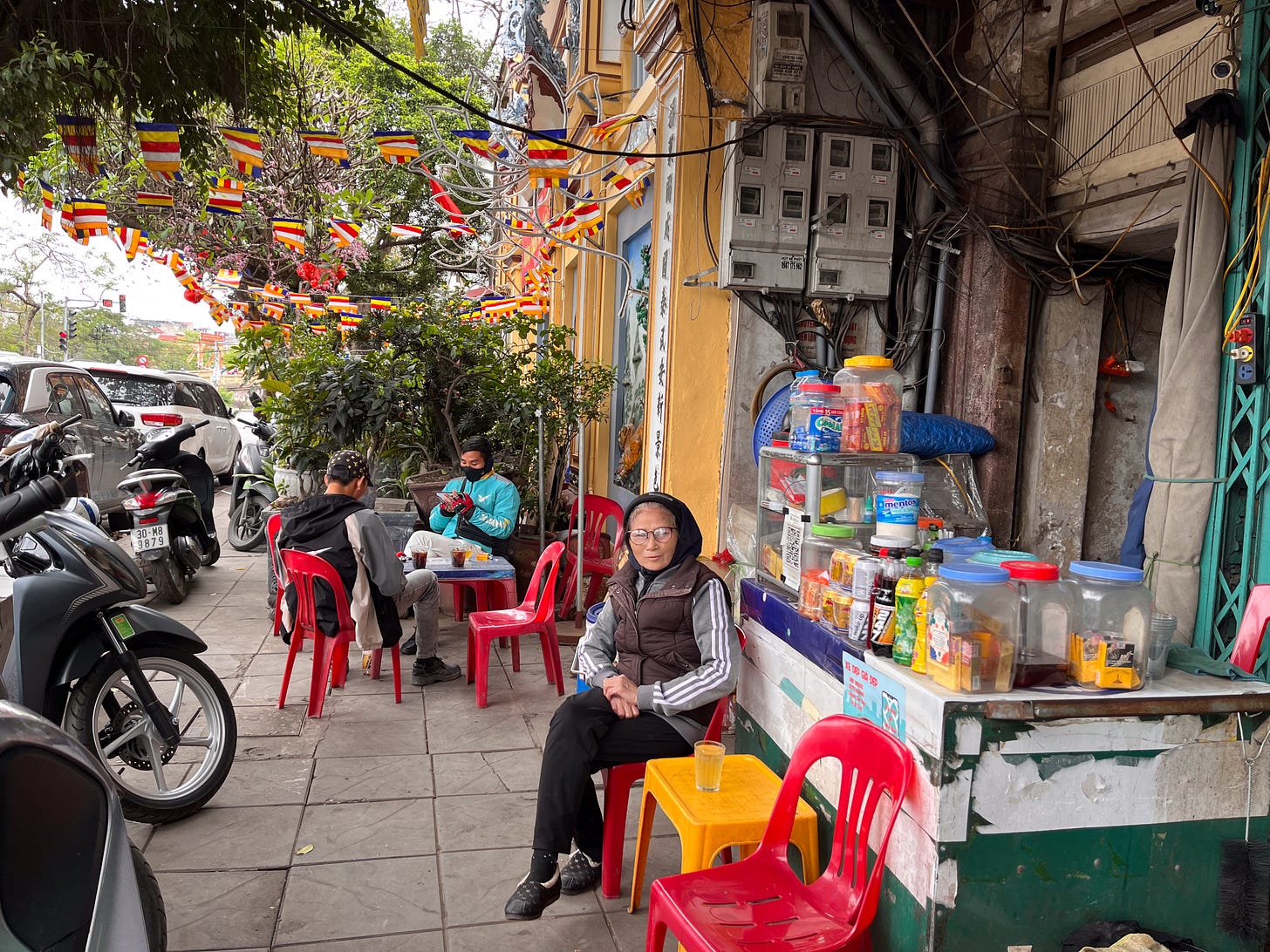Trà Đá: How a Simple Tea Became Hanoi’s Social Glue
Tracing the rise of Trà Đá from post-war hustle to cultural icon, learn how a humble iced tea became Hanoi’s great social equalizer
It’s a mild afternoon on Yen Phu street in the Old Quarter, the heart of Hanoi. The air is humid and thick; you can see the droplets of water surfacing on your skin. “Chaotic” is an understatement as the noise of motorbikes weaving through traffic, horns being honked and the chatter of people fill your ears. The street is scattered with colorful buildings decorated with vendors selling anything from fruits to clothes.
Next to the Phuc Lam temple, Ms. Thinh is stationed with a couple of plastic chairs and stools selling trà đá, just as she’s been doing for the last 20 years. Trà đá is a refreshing, strongly brewed tea chilled with ice. Unlike sweeter iced teas found elsewhere, trà đá is usually unsweetened, allowing the natural and slight bitter flavor of the tea to shine through. While trà đá is typically made with green tea, the tea base itself is made from chè – dried or fresh tea leaves that are mostly jasmine.
Green tea has a long history in Vietnam, dating back over 4,000 years and was traditionally, only served hot on the family table. After the war, Vietnam entered the Subsidy Era, where shortages of basic necessities like food, potable water, and economic opportunities were limited and heavily controlled by the government. As unemployment rates skyrocketed and poverty peaked at an all time high, the government changed their economic system from government-centered to a free market economy in 1986. The Renovation, also known as Đổi Mới, allowed Vietnamese citizens to have more freedom to do their business and as a result people started selling their goods on the street: green tea became part of this phenomenon.

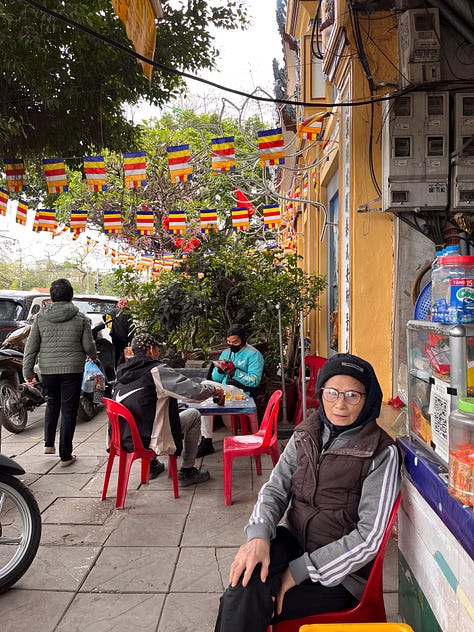

As Ms. Thinh, now 65, pours me a cup of iced tea after serving 2 Grab drivers (equivalent to Uber but with motorcyclists) taking a break in her shop. She tells me about the early years of her business: just finishing service from the military and unable to find a job, she rented a shop near her house to sell both food and drinks but couldn’t handle everything herself, so she decided to sell tea only: “I used to carry the whole shop on my shoulders, selling around the Long Bien market. I would run away every time the police caught me selling drinks on the sidewalk. Now I am old, so my sister and I take turns running the shop next to the temple as my health doesn’t allow me to walk too much.” I could not imagine how her small body could handle the weight of everything; it was not just her shop but also the responsibility of a mom doing her best to raise her two daughters, and now, she is carrying a part of the culture on her tiny shoulders.
Ice was starting to be used during that time as the global trend of cold beverages grew; since fridges were not common in the city during that time, only rich people could afford them. As the country was still recovering from the war, an electricity shortage led to ice scarcity and as a result, iced tea became even more desirable. Vendors started buying ice from people who had refrigerators and selling iced tea on the road. It continued to be a luxury drink until the 2000s, when access to ice became easier due to economic growth and many people started to sell trà đá to make a living, the cost reduced significantly. After this, trà đá became a cheap, easy, and common drink for all people, especially on a hot day in summer.
To attract more customers, vendors would usually sell on the sidewalk in front of crowded places like stations, markets, and schools – something that was illegal at the time. To allow them a quick getaway in case the police decided to stop by, they had simple setups with plastic chairs and stools.
With the new generations introducing additions of new flavors in iced tea such as lime, tangerine, or dragon plum – Ms. Thinh makes sure to be in tune with what her customers want to attract more business. “Trà đá is probably still the most popular drink. Other canned drinks like Coca Cola or sweetened lemon tea are also favorites of kids, especially in summer. I couldn't make those drinks, so I just bought them from the grocery store, and the price could be a little bit higher, which allows me to make a living.”
It is not hard to catch a group of friends, family, neighbors, or colleagues sitting, chatting and enjoying tea in front of universities, offices, or shopping malls. They seem to be unbothered by the noise of traffic or the heat of the sun, only the slightly bitter flavor of the tea and the jokes of a friend catch their attention. Trà đá is a reflection of Hanoi street food culture centered around its accessibility and affordability; it is cheaply available to anyone, just 3,000-5,000 VND (0.12 - 0.20 USD) for a cup. Students, workers, officers, celebrities...all can drink and enjoy as access to this social experience is not limited by class or wealth.
Trà đá vendors are called "Vietnamese Street Press Agency" not by chance. “Most older people gather here in the afternoon or evening after they go for a walk or play sports, as they love chatting with each other about many things in life. I think trà đá brings people together and it belongs to ‘the street culture.’ People meet warmly, sit, and talk happily while having iced tea,” Ms Thinh says.
Young people in Hanoi, just like the elders, flock to trà đá vendors for a quick cup of iced tea. Their relationship with trà đá is not just as a tool to quench their thirst, but goes beyond that as a break from their busy lives as a peaceful afternoon talking with friends about social problems, stresses from work, and other issues. What can be better than spending two hours next to a lake, taking a sip of cold tea and sharing your laughter with your favorite people? According to Ms. Thinh, her young customers tend to come in the morning before going to work. After having breakfast, such as a bánh mì or a bowl of phở, a cup of tea is ideal. She mentions those who needed to go to work wouldn’t stay for long, but if they could, they would be there for hours.
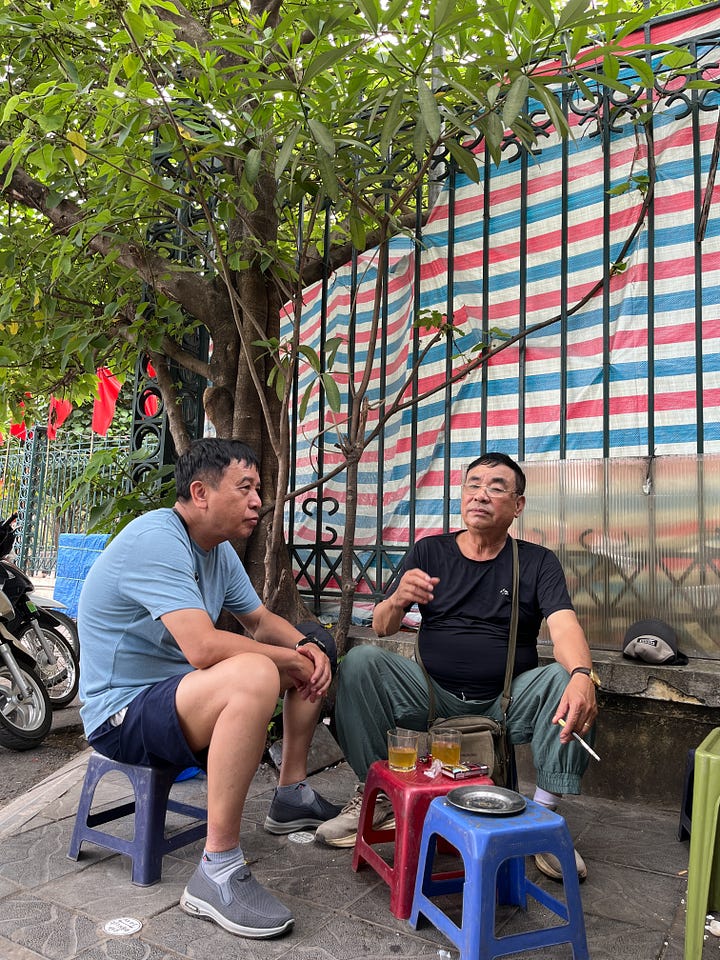
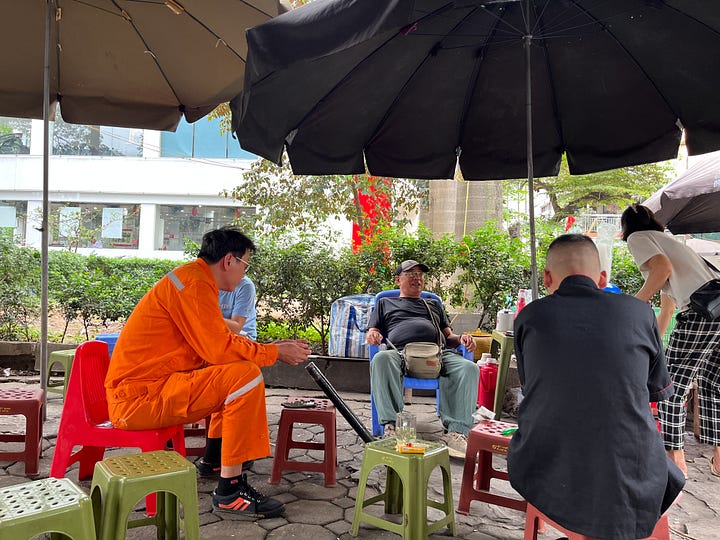
The simple and familiar image of the tea touches people and reminds them about the simplicity of life. Trà đá, in those photos, represents Hanoi itself- lively, casual, and welcoming. Lately, images of trà đá were included in some popular music videos, indirectly promoting the culture, allowing for a huge influx of the younger generation. Ms Thinh expressed “I hope young people can keep the culture of trà đá alive through times, but I know it depends a lot on our society. Life is so developed now and they have many choices, people spend more time on the phone, and I am grateful for every customer visiting my shop.”
As life keeps modernizing, trà đá finds its way to weave into youth culture. Appearing frequently on social media, it has become a symbol of Hanoi’s charm. The simple image of the tea among the chaos of Hanoi touches people and reminds them about the simplicity of life in this modern world. It reminds you to take a break, take a deep breath, and allow yourself to forget all the troubles. Trà đá represents Hanoi itself: lively, casual, and welcoming.


From its humble beginning as a simple tea to a beloved part of people's life in Hanoi, trà đá offers a shared zone for conversation, laughter, and community, bringing people together beyond their class, age, or walk of life.
Ms Thinh with her tiny trà đá shop has become an integral part of Hanoi’s street culture. Her role is not just about selling tea, but also about preserving and passing on cultural heritage through the test of time. Whether it's the older generations who gather at her shop to chat about life or the young people who post their moments on social media, Ms. Thinh’s humble corner stall remains a place where the rhythms of the city meet the warmth of community.
As Hanoi keeps growing and modernizing, the future of trà đá and many of its vendors is uncertain. Younger generations may no longer see selling tea as a viable way to make a living, and the city’s efforts to reclaim sidewalks for pedestrians could gradually push these street-side stalls out. Yet, people like Ms. Thinh who keep selling this tea give us hope. Trà đá with its amazing journey, remains a timeless part of Hanoi’s rhythm and will always stay in the heart of Hanoi culture.
This piece was written by
. Born and raised in Quang Binh, Vietnam, living in Hanoi and now Da Nang, Ovia writes both in her native language, Vietnamese, and English.Sources
https://daidoanket.vn/tra-da-via-he-thuc-uong-binh-dan-cua-nguoi-ha-noi-10255547.html
https://luhanhvietnam.com.vn/du-lich/tra-da-via-he-ha-noi-noi.html?utm
https://hanoilanguage.vn/tra-da-dac-san-cua-nguoi-ha-noi/?utm
https://hanoionline.vn/ben-ly-tra-da-via-he-co-mot-ha-noi-binh-yen-276736.htm
https://vinpearl.com/en/vietnamese-iced-tea-a-wonderful-part-of-the-local-culture?utm
https://vitas.org.vn/vi/blog/van-hoa-tra-viet-nam.html
https://haithuy.vn/van-hoa-tra-da-chill-cung-net-dep-gian-di-cua-gioi-tre-viet/
Funny Table is an independent food publication and video channel dedicated to teaching you more about what you eat. We’re a small volunteer team committed to telling stories that reflect the diverse voices, cultures, and communities that shape what’s on our plates. Every share, comment, like, and subscription helps us keep going.]
Liked this piece? Let us know your thoughts!
Enjoy educational media and stories about food? Check out our videos on YouTube and Instagram for more.




